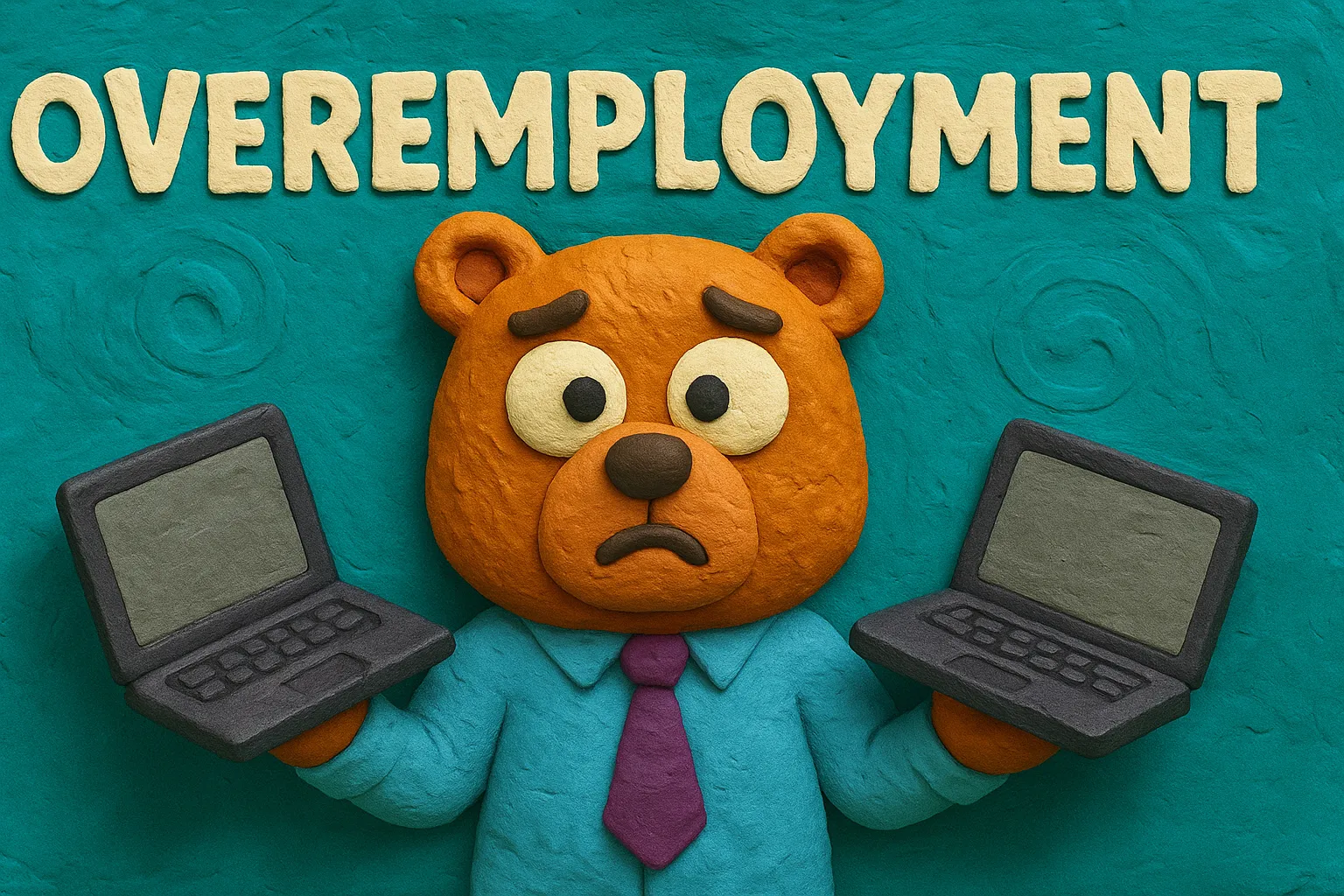


Meet Sally: a senior developer by day… and another senior developer by, well, day again. He wakes up, opens two Slack channels, and masterfully juggles code reviews, standups, and project deadlines from not one, but two full-time remote gigs.
Sounds exhausting? It is. But it’s also becoming surprisingly common.
Welcome to the not-so-secret world of overemployment, where professionals in tech secretly hold two (or more!) full-time jobs, often without their employers knowing. Once seen as career sabotage or corporate betrayal, it’s now emerging as a calculated career move.
Fueled by remote work, flexible schedules, and corporate downsizing, overemployment is no longer an edge-case phenomenon. It’s the shadow side of the modern work-from-home revolution.
Let’s unpack it, with a bit of mischief, a dash of data, and a whole lot of curiosity.

If you think overemployment is just another side hustle, think again.
Overemployment = working two or more full-time jobs at once without telling your employers.
It’s not your grandma’s Etsy shop or freelance copywriting gig. This is stealth mode, secret-agent-level multitasking. Employees log into overlapping daily standups, juggle Jira tickets from different orgs, and mute Zoom meetings like seasoned performers.
And while the concept might sound extreme, it’s not that rare:
Various surveys show that 6–8% of tech professionals have engaged in overemployment at some point. For senior engineers, that number may be even higher.
Yes, it’s about the money.But also… not just about the money.
Here’s what overemployed professionals say motivates them:
"On one salary, I can live. On two? I can save, invest, travel, and build."
From crypto portfolios and house deposits to funding personal projects, overemployment is often less about survival, more about strategy.
Tech layoffs aren’t theoretical anymore. With employment stability increasingly tied to quarterly earnings, many use overemployment as an income buffer.
"I’m not gambling on one company. If one goes down, the other keeps me afloat."
Especially in the U.S., where unemployment safety nets are thinner than a non-compete clause.
Overemployment isn’t always mercenary. Some use the second job to:
"One job feeds my wallet. The other feeds my soul."
Two jobs across two continents? Not a problem with async workflows and timezone offsets.
"Zoom fatigue" may be real, but so is the scheduling magic that lets someone hop from one sprint review to another with minimal friction.
Interestingly, team leads and junior employees are the least likely to engage in overemployment.
Why?
But seniors? They’ve optimized workflows, learned how to manage up, and often have the autonomy (and boredom) that makes doubling up possible.
"Senior devs write less code and attend more meetings. Perfect overemployment conditions."
While micromanaging isn’t the answer, there are signs managers can look for:
Of course, these can also be signs of burnout or poor alignment, so tread carefully. Transparency, trust, and regular 1:1s are more effective than surveillance.
Is it deceitful? Illegal? Depends on the contract.
Bottom line: it's not the second job that’s the problem. It’s hiding it, especially when it interferes with performance or breaches confidentiality.
In the U.S., reactions range from:
Startups sometimes knowingly hire senior talent on a part-time or overcommitted basis to get cheaper access to top-tier skills.
Europe takes overemployment more seriously. Unionized environments, explicit labor protections, and regulated working hours create a stricter context.
But even there, enforcement is tough unless performance drops or a conflict of interest is exposed.
Here’s a spicy take: Overemployment might be a symptom of underemployment.
If your senior dev is working two jobs, ask: Why?
Instead of hunting down double-dippers, companies could:
Overemployment thrives in opacity. Salary transparency and open dialogue can starve it.
PayScope.ai exists exactly for this reason: to empower workers (and employers) with real, benchmarked compensation insights.
So, is overemployment here to stay?
Signals suggest it might evolve, not disappear.
But as burnout data piles up and companies catch on, the stealth mode may shift toward transparent dual employment or portfolio careers.
Platforms like PayScope.ai could play a role here: helping workers validate their worth without resorting to working double-time in the shadows.
If you’re juggling two roles, ask yourself why.
Is it about freedom? Fear? Frustration? Or simply not being paid what you’re worth?
Before you onboard another Slack channel, spin up another Zoom call, or silently scream into another Jira board, check your market value.
With PayScope.ai, you can:
Because maybe you don’t need another job. Maybe you just need a better one.
Know your worth with real-time, resume-based salary insights. No guessing. No forms. Just fast, personalized results, completely free.